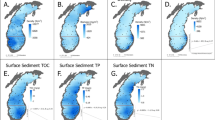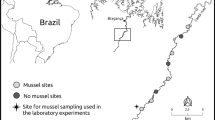Abstract
Dreissenid mussels are notorious invasive organisms whose establishment is associated with large, ecosystem-scale changes to patterns of productivity in aquatic systems. We investigated how localized impacts of dreissenids affect the potential of littoral substrates to support primary and secondary production using in situ incubations and comparisons of natural mussel-colonized and mussel-free substrates in the littoral zone of a large, shallow lake. We compared dreissenid-colonized and dreissenid-free substrates in terms of nutrient balance, surface area, periphyton loads as well as benthic primary production and respiration rates. Dreissenid-colonized substrates acted as sources of dissolved nutrients to the water column, with mussel mass-specific rates of dissolved phosphorus and ammonia excretion averaging 7.2 ± 5.6 (mean ± SD), and 92.6 ± 64.7 μg/g mussel shell free dry mass/h, respectively. Mussel-colonized substrates also had higher surface area, and supported approximately double the amount of periphyton and organic matter loads compared to mussel-free substrates, as well as having higher rates of primary production and community respiration. We suggest that the localized effects of dreissenids can play an important role in changing whole-ecosystem production patterns, with the extent of dreissenid impacts strongly dependent on lake size and morphometry.




Similar content being viewed by others
References
Ackerman JD (1999) Effect of velocity on the filter feeding of dreissenid mussels (Dreissena polymorpha and Dreissena bugensis): implications for trophic dynamics. Can J Fish Aquat Sci 56:1551–1561
American Public Health Association (1998) Standard methods for the examination of water and wastewater, 20th edn. American Public Health Association, Washington
Arnott DL, Vanni MJ (1996) Nitrogen and phosphorus recycling by the zebra mussel(Dreissena polymorpha) in the western basin of Lake Erie. Can J Fish Aquat Sci 53:646–659
Boegman L, Loewen MR, Hamblin PF, Culver DA (2008) Vertical mixing and weak stratification over zebra mussel colonies in western Lake Erie. Limnol Oceanogr 53:1093–1110
Brown JE, Stepien CA (2010) Population genetic history of dreissenid mussel invasions: expansion patterns across North America. Biol Invasions 12:3687–3710
Bruesewitz DA, Tank JT, Bernot MJ (2008) Delineating the effects of zebra mussels (Dreissena polymorpha) on N transformation rates using laboratory mesocosms. J N Am Benthol Soc 27:236–251
Bunt CM, Maclsaac HJ, Sprules WG (1993) Pumping rates and projected filtering impacts of juvenile zebra mussels (Dreissena polymorpha) in western Lake Erie. Can J Fish Aquat Sci 50:1017–1022
Burks RL, Tuchman NC, Call CA (2002) Colonial aggregates: effects of spatial position on zebra mussel responses to vertical gradients in interstitial water quality. J N Am Benthol Soc 21:64–75
Cecala RK, Mayer CM, Schulz KL, Mills EL (2008) Increased benthic algal production in response to the invasive zebra mussel (Dreissena polymorpha) in a productive ecosystem, Oneida Lake, New York. J Integr Plant Biol 50:1452–1466
Conroy JD, Edwards WJ, Pontius RA, Kane DD, Zhang H, Shea JF, Culver DA (2005) Soluble nitrogen and phosphorus excretion of exotic freshwater mussels (Dreissena spp.): potential impacts for nutrient remineralization in western Lake Erie. Freshw Biol 50:1146–1162
Coughlan J (1969) The estimation of filtering rate from the clearance of suspensions. Mar Biol 2:1146–1162
Crooks JA (2002) Characterizing ecosystem-level consequences of biological invasions: the role of ecosystem engineers. Oikos 97:153–166
Davis JM, Hecky RE (2005) Initial measurements of benthic photosynthesis and respiration in Lake Erie. J Great Lakes Res 21(suppl 2):195–207
Edwards WJ, Rehmann CR, McDonald E, Culver DA (2005) The impact of a benthic filter feeder: limitations imposed by physical transport of algae to the benthos. Can J Fish Aquat Sci 62:205–214
Ehrenfeld JG (2003) Effects of exotic plant invasions on soil nutrient cycling processes. Ecosystems 6:503–523
Evans DO, Nicholls KH, Allen YC, McMurtry MJ (1996) Historical land use, phosphorus loading, and loss of fish habitat in Lake Simcoe, Canada. Can J Fish Aquat Sci 53:194–218
Evans DO, Skinner AJ, Allen R, McMurtry MJ (2011) Invasion of zebra mussel, Dreissena polymorpha, in Lake Simcoe. J Great Lakes Res 37(suppl 3):36–45
Fréchette M, Butman CA, Geyer RW (1989) The importance of boundary-layer flows in supplying phytoplankton to the benthic suspension feeder, Mytilus edulis L. Limnol Oceanogr 34:19–36
Gergs R, Rinke K, Rothhaupt KO (2009) Zebra mussels mediate benthic–pelagic coupling by biodeposition and changing detrital stoichiometry. Freshw Biol 54:1379–1391
Ginn BK (2011) Distribution and limnological drivers of submerged aquatic plant communities in Lake Simcoe (Ontario, Canada): utility of macrophytes as indicators of lake trophic status. J Great Lakes Res 37(suppl 3):83–89
Hecky RE, Smith REH, Barton DR, Guildford SJ, Taylor WD, Charlton MN, Howell T (2004) The nearshore phosphorus shunt: a consequence of ecosystem engineering by dreissenids in the Laurentian Great Lakes. Can J Fish Aquat Sci 61:1285–1293
Higgins SN, Vander Zanden MJ (2010) What a difference a species makes: a meta–analysis of dreissenid mussel impacts on freshwater ecosystems. Ecol Monogr 80:179–196
Holmes RM, Aminot A, Kérouel R, Hooker BA, Peterson BJ (1999) A simple and precise method for measuring ammonium in marine and freshwater ecosystems. Can J Fish Aquat Sci 56:1801–1808
James WF, Barko JW, Eakin HL (2001) Phosphorus recycling by zebra mussels in relation to density and food resource availability. Hydrobiologia 455:55–60
Jimenez A, Rennie MD, Sprules WG, La Rose J (2011) Temporal changes in the benthic invertebrate community of Lake Simcoe, 1983–2008. J Great Lakes Res 37(suppl 3):103–112
Karatayev AY, Burlakova LE, Padilla DK (1997) The effects of Dreissena polymorpha (Pallas) invasion on aquatic communities in Eastern Europe. J Shellfish Res 16:187–203
Klerks PL, Fraleigh PC, Lawniczak JE (1996) Effects of zebra mussels (Dreissena polymorpha) on seston levels and sediment deposition in western Lake Erie. Can J Fish Aquat Sci 53:2284–2291
MacIsaac HJ, Sprules G, Johannson OE, Leach JH (1992) Filtering impacts of larval and sessile zebra mussels (Dreissena polymorpha) in western Lake Erie. Oecologia 92:30–39
Malkin SY, Guildford SJ, Hecky RE (2008) Modeling the growth response of Cladophora in a Laurentian Great Lake to the exotic invader Dreissena and to lake warming. Limnol Oceanogr 53:1111–1124
Mayer CM, Keats RA, Rudstam LG, Mills EL (2002) Scale-dependent effects of zebra mussels on benthic invertebrates in a large eutrophic lake. J N Am Benthol Soc 21:616–633
McLean K (2011) Experimental studies on the erodibility and transport behaviour of dreissenid mussel deposits in an annular flume. MSc thesis dissertarion, University of Waterloo
Naddafi R, Pettersson K, Eklöv P (2008) Effects of the zebra mussel, an exotic freshwater species, on seston stoichiometry. Limnol Oceanogr 53:1973–1987
Ostrom NE, Carrick HJ, Twiss MR, Piwinski L (2005) Evaluation of primary production in Lake Erie by multiple proxies. Oecologia 199:115–124
Ozersky T, Malkin SY, Barton DR, Hecky RE (2009) Dreissenid phosphorus excretion can sustain C. glomerata growth along a portion of Lake Ontario shoreline. J Great Lakes Res 35:321–328
Ozersky T, Barton DR, Depew DC, Hecky RE, Guildford SJ (2011a) Effects of water movement on the distribution of invasive dreissenid mussels in Lake Simcoe, Ontario. J Great Lakes Res 37(suppl 3):46–54
Ozersky T, Barton DR, Evans DO (2011b) Fourteen years of dreissenid presence in the rocky littoral zone of a large lake: effects on macroinvertebrate abundance and diversity. J N Am Benthol Soc 30:913–922
Palmer ME, Winter JG, Young JD, Dillon PJ, Guildford SJ (2011) Introduction and summary of research on Lake Simcoe: research, monitoring, and restoration of a large lake and its watershed. J Great Lakes Res 37(suppl 3):1–6
Quinn GP, Keough MJ (2002) Experimental design and data analysis for biologists. Cambridge University Press, Cambridge
Rawson DS (1930) The bottom fauna of Lake Simcoe and its role in the ecology of the lake. University of Toronto Press, Toronto
Riber HH, Wetzel RG (1987) Boundary-layer and internal diffusion effects on phosphorus fluxes in lake periphyton. Limnol Oceanogr 32:1181–1194
Silver Botts PS, Patterson BA, Schloesser DW (1996) Zebra mussel effects on benthic invertebrates: physical or biotic? J N Am Benthol Soc 15:179–184
Sousa R, Gutiérrez JL, Aldridge DA (2009) Non-indigenous invasive bivalves as ecosystem engineers. Biol Invasions 11:2367–2385
Stewart TW, Miner JG, Lowe RL (1998) Quantifying mechanisms for zebra mussel effects on benthic macroinvertebrates: organic matter production and shell-generated habitat. J N Am Benthol Soc 17:81–94
Strayer DL, Eviner VT, Jeschke JM, Pace ML (2006) Understanding the long-term effects of species invasions. Trends Ecol Evol 21:645–651
R core development team (2005) R: a language and environment for statistical computing. R foundation for statistical computing. Available from: http://www.R-project.org
Turner CB (2010) Influence of zebra (Dreissena polymorpha) and quagga (Dreissena rostriformis) mussel invasions on benthic nutrient and oxygen dynamics. Can J Fish Aquat Sci 67:1899–1908
Vander Zanden JM, Casselman JM, Rasmussen JB (1999) Stable isotope evidence for the food web consequences of species invasions in lakes. Nature 401:464–467
Vanderploeg HA, Liebig JR, Nalepa TF, Fahnenstiel GL, Pothoven SA (2010) Dreissena and the disappearance of the spring phytoplankton bloom in Lake Michigan. J Great Lakes Res 36:50–59
Young J, Landre A, Winter J, Jarjanazi H, Kingston J (2010) Lake Simcoe water quality update. Ontario Ministry of the Environment, Toronto
Yu N, Culver DA (1999) Estimating the effective clearance rate and refiltration by zebra mussels, Dreissena polymorpha, in a stratified reservoir. Freshw Biol 41:481–492
Acknowledgments
The authors are grateful to Ryan Scott, Adam Houben, Tyrell Worral, Jennifer Hood, Erin Jones, Lee Pinnel, Lin Lee, Jessica Pang and Dylan Pallett for assistance in the field and in the lab. We thank Jake LaRose and the staff of the Lake Simcoe Fisheries Assessment Unit for providing lab space and putting up with the noise of our vaccum pump. This manuscript was substantially improved thanks to insightful comments from the associate editor and two anonymous reviewers. Funding for this project was provided through an Ontario Ministry of the Environment Best in Science grant to SJG.
Author information
Authors and Affiliations
Corresponding author
Rights and permissions
About this article
Cite this article
Ozersky, T., Barton, D.R., Hecky, R.E. et al. Dreissenid mussels enhance nutrient efflux, periphyton quantity and production in the shallow littoral zone of a large lake. Biol Invasions 15, 2799–2810 (2013). https://doi.org/10.1007/s10530-013-0494-z
Received:
Accepted:
Published:
Issue Date:
DOI: https://doi.org/10.1007/s10530-013-0494-z




